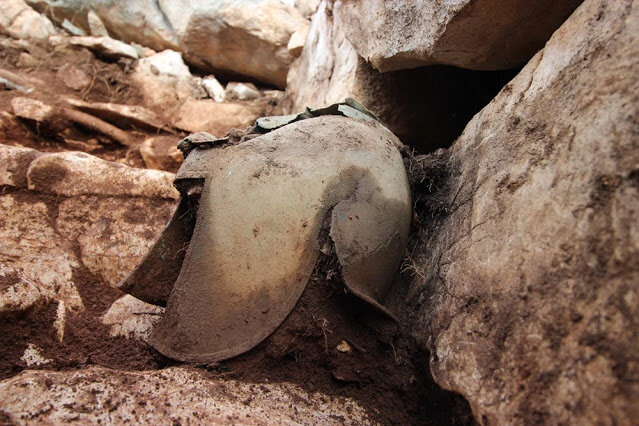The exceptional find of a Greek-Illyrian helmet, as well as numerous other valuable grave goods have been found during the archaeological excavations of graves from the fourth century BC in Zakotarac on the Pelješac peninsula, in southern Dalmatia, Croatia.
![Greek-Illyrian helmet [Credit: Dubrovnik Museums]](https://nguoinghe24h.com/wp-content/uploads/2024/01/Croatia-01.jpg)
“We explored a tomb from the 4th century BC that belonged to a member of the warrior elite in which we found a Greek-Illyrian helmet. In the grave we also found fragments of other iron weapons such as spears and knives. However, in addition to the warrior, at least two more persons were buried, one of whom was a woman, as indicated by the fragments of a bronze bracelet.
![Silver fibula and bronze needle from Zakotorac [Credit: Dubrovnik Museums]](https://nguoinghe24h.com/wp-content/uploads/2024/01/Croatia-08c.jpg)
The helmet itself is the standard type we call the Greek-Illyrian helmet. Such a helmet has several developmental stages, and this variant from the fourth century BC was used in both Greek and Illyrian areas. It is bronze, has a solid head protection and a characteristic rectangular cut for the face. To date, only about 40 have been found in Europe,” says project coordinator Dr. Hrvoje Potrebica from the Department of Archaeology of Zagredb University.

“Among other findings retrieved from the graves are fifteen bronze and silver fibulae (clasps), a dozen needles, several spiral bronze ornaments and tweezers and several hundred glass paste and amber beads belonging to necklaces. So far, a little more than thirty different vases have been identified, mostly of Greek provenance, probably from Attic and Italian workshops.
![Greek-Illyrian helmet at time of discovery [Credit: Dubrovnik Museums]](https://nguoinghe24h.com/wp-content/uploads/2024/01/Croatia-04.jpg)
It should be emphasized that these were the most expensive vases of that time, which the local population placed with their deceased as a grave offering for their afterlife. We cannot know whether such vessels are the result of trade or robbery (piracy), but they were certainly very aware of their value”, explained Dr.Domagoj Perkić, curator of the Dubrovnik Museums..
![The rock-cut tomb in which the helmet was found [Credit: Dubrovnik Museums]](https://nguoinghe24h.com/wp-content/uploads/2024/01/The-rock-cut-tomb-in-which-the-helmet-was-found-1350x900-1.jpg)
In 2019, a team from the Center for Prehistoric Research, whose founder and president is Professor Potrebica, visited western Peljesac at the invitation of a local historical society. They soon identified several areas of archaeological interest in the immediate vicinity of the Illyrian Cave Sanctuary at Nakovana, which was found and explored by Dr. Stašo Forenbaher, and where religious rites were performed to unknown fertility deities from the fourth to the first centuries BC. The population of that time left a multitude of offerings at the site, as evidenced by the large amount of fine Hellenistic pottery deposited around a ‘phallic’ stalagmite.
“We have implemented a scientific approach that covers the entire landscape, not just individual sites, employing the highest research standards. The result is that, in addition to the cave, we have identified many other hitherto unknown sites in Nakovana,” said Professor Potrebica. “Nakovana is dominated by a fortified high-altitude settlement on Gradina hill, providing an impressive view of the entire landscape dotted with stone mounds and flat graves, almost completely hidden in the rocky and impassable terrain.”
At the same, the team came across another prehistoric landscape around the village of Zakotorac. These are prehistoric mounds from different periods around the hillfort on the hill Kotorac. From the presumed prehistoric settlement, a series of mounds probably point to a prehistoric road to the Vidohovo spring where there might also be a shrine, the researchers concluded.
![Fragment of a skyphos depicting Pan or someone from his entourage [Credit: Dubrovnik Museums]](https://nguoinghe24h.com/wp-content/uploads/2024/01/Croatia-08d.jpg)
“The grave from which the helmet was excavated was found during the restoration of one of the damaged mounds, most of which had been more or less ransacked. The tomb is a large rectangular space measuring approximately 3 x 2 metres and is not bordered by slabs, but is sunk directly into the bedrock. Although the bones of the deceased are in rather poor condition, they are presumed to have been laid approximately in a west-east direction. These finds date somewhat earlier than the colony on Korčula that was founded in the late 4th or early 3rd century BC,” explains Professor Potrebica.
![Gradina hilltop town in Nakovana [Credit: Dubrovnik Museums]](https://nguoinghe24h.com/wp-content/uploads/2024/01/Croatia-08.jpg)
This is the first in a series of activities of a long-term research project that aims to explore and present the prehistoric landscapes of Peljesac. Fantastic findings and extremely valuable scientific results, achieved through volunteer work despite the lack of funds and great operational difficulties, give a hint of the huge potential that this area has for archaeology and cultural tourism.
“The enormous potential of this site will encourage a more systematic approach to overall research. We hope that next year we will have the opportunity to continue our research to give the findings a broader context and to better understand, adequately protect and, in cooperation with the local community, present these unique landscapes that, combined with exceptional finds on Korcula, open a completely new picture of the importance of the southern Adriatic in the historical dynamics of this part of Europe,” said Potrebica.





